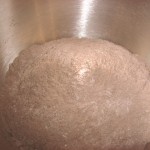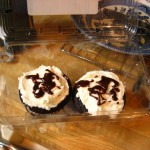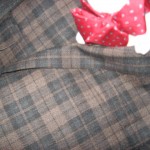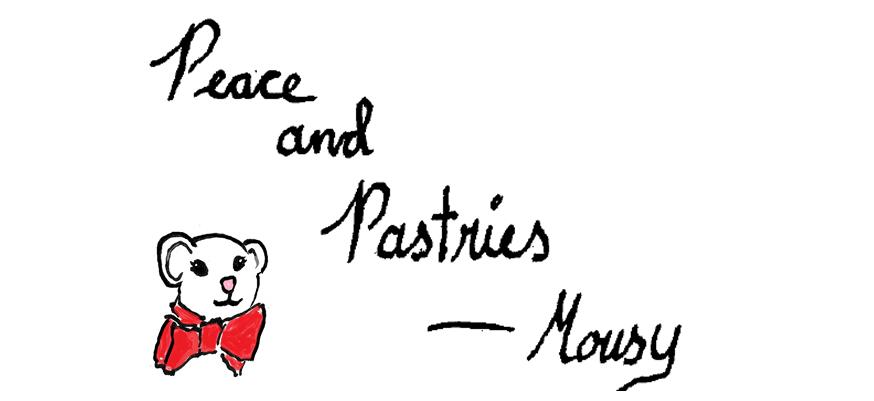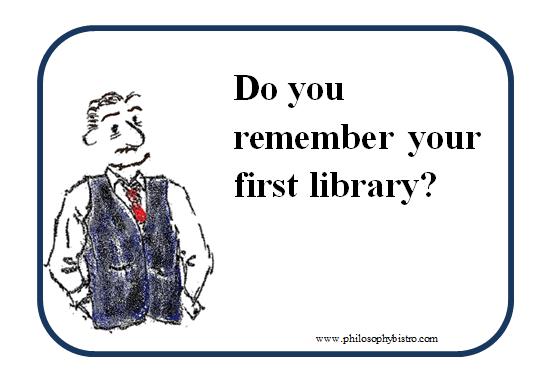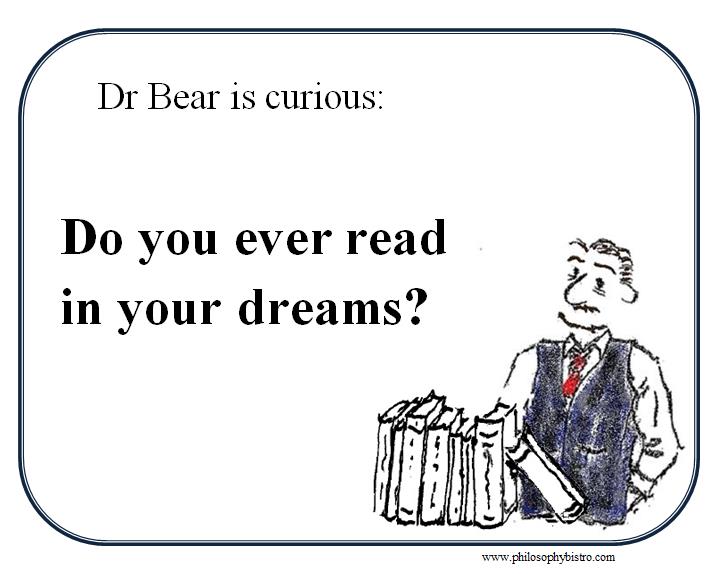 Do you read in your dreams?
Do you read in your dreams?
The background for this is a Psychology student who once argued with me that one couldn’t read in dreams. I replied that I did–often. He said: “Oh, you weren’t reading; you only thought you were.” I pointed out that that’s what all dreams are.
Monthly Archives: April 2014
Blazing Cupcakes
 I don’t know if any of you remember a cake I made a few weeks ago that I called Fireman’s Cake.
I don’t know if any of you remember a cake I made a few weeks ago that I called Fireman’s Cake.
It went over pretty well, so I decided to make it again as cupcakes.
Ingredients:
- 2 1/2 cups all-purpose flour
- 3/4 cup powdered chocolate
- 1 tsp. baking powder
- 1/2 tsp. salt
- 1 tsp. cayenne pepper
- 1 tsp. hot paprika
- 1 tsp. ground cinnamon
- 1 cup strong Lapang Souchong Tea (feel free to substitute another liquid)
- 1/2 tsp. baking soda
- 1 cup dark molasses (not black strap)
- 1 cup packed dark brown sugar
- 1 cup granulated sugar
- 3 large eggs
- 1/2 cup softened butter
- 1/2 cup dark chocolate chips
For the Frosting:
- ½ pound softened butter
- 4 cups sifted powdered sugar
- ¼ tsp. salt
- 1 Tbsp. vanilla extract
- 2 – 4 Tbsp. heavy cream
- additional heavy cream or sugar as needed
- Sugar for the top
Step 1, Prepare ye the way: Pre-heat the oven to 350, and prepare the cupcake pans. I use papers and spray a bit of olive oil in them so the cakes some out more easily, but it’s your choice. This makes about 2 dozen cupcakes.
Also assemble all the ingredients on the counter.
Step 1, B: Crap! How could we run out of that?!?
Step 2, sifting the dry ingredients: In a large bowl, sift the flour, chocolate, baking powder, salt, cinnamon, paprika, and pepper. Set aside.
Step 3, mixing the wet ingredients: in a big bowl, mix the warm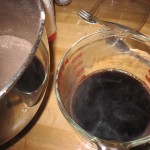 tea and carefully (!) add the baking soda (this is like the elementary school volcano experiment, but also like my soft pretzel/laugen recipe), whisking it smooth. After the foaming subsides, whisk in and dissolve molasses, the brown and white sugars, and the butter, and then, as it cools, the eggs.
tea and carefully (!) add the baking soda (this is like the elementary school volcano experiment, but also like my soft pretzel/laugen recipe), whisking it smooth. After the foaming subsides, whisk in and dissolve molasses, the brown and white sugars, and the butter, and then, as it cools, the eggs.
Step 4, combining: Add the wet ingredients to the dry ingredients, maybe about a third at a time, mixing thoroughly. You don’t want pockets of dry, floury ingredients.
Step 5, putting it in the pan/pans: Add half the mixture to the prepared pan/pans, sprinkle this with half of the chocolate chips, then pour in the rest of the mixture and sprinkle with (you guessed this, didn’t you) the rest of the chips. They should sink into the batter.
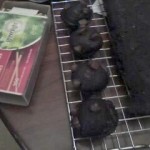 Step 6, pop it in the oven for baby & me: bake the pans at 350 for 20 minutes or more, depending on the size of pans you chose, or until you can stick a toothpick in it and pull it out without it being covered with batter. Take it out, let it sit for a minute or so, then take it from the pan onto a wire rack to cool all the way.
Step 6, pop it in the oven for baby & me: bake the pans at 350 for 20 minutes or more, depending on the size of pans you chose, or until you can stick a toothpick in it and pull it out without it being covered with batter. Take it out, let it sit for a minute or so, then take it from the pan onto a wire rack to cool all the way.
Part the Second: the frosting
Step 7, beat it! beat it! in a mixer, beat the softened butter. Add in the powdered sugar, and mix slowly at first (avoiding a sweet dust storm), then go up to medium.
Step 8, Add-ins: Add in the salt, the vanilla, and 2 tablespoons of cream. 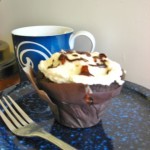 If it is too runny, add more sugar, likewise more cream if it is too stiff. Whip it to your preference. (send me your 50 Shades or other off-color joke to insert here)
If it is too runny, add more sugar, likewise more cream if it is too stiff. Whip it to your preference. (send me your 50 Shades or other off-color joke to insert here)
Step 9, Frost: frost it as you like. I like using a cookie press for the designs of the nozzle, but I can’t ever find mine.
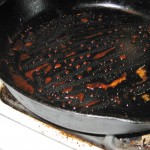 Part the Third: the finishing touch (optional)
Part the Third: the finishing touch (optional)
Step 10, Smoke: Scorch some sugar and sprinkle it on top. A sugar cube scorched with a Brûlée Torch is an idea. I sprinkled some brown sugar and a pinch of sea salt on a very hot griddle, and then drizzled this on the frosting.
This is dangerously hot!
Step 11, Share: take it to work or to the house of someone you love. Or freeze them to thaw later.
Tweed
Dr Bear is rather busy at the moment, and behind on his deadlines (no surprise there). I have never been exactly clear on the rationale behind mowing lawns; it seems like such a waste of time. However, I decided to burrow in and give it a try.
On Easter, we had a sweet discussion with Alex, our fantasy IT girl, and some really cool girl (Katie? Maybe?) about tweed.
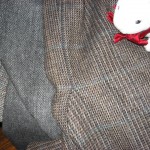 Tweed is a rough surfaced woolen cloth, generally marked by irregular variations in color. The predominant colors are natural and earth-tones, especially the browns and grays of traditional wools and woolen dyes. The threads of the wool are wide and irregular—twills of wool that probably gave tweed its original name. The epicenter of tweeds is along the Tweed river in Scotland, but tweeds are woven throughout the British Islands.
Tweed is a rough surfaced woolen cloth, generally marked by irregular variations in color. The predominant colors are natural and earth-tones, especially the browns and grays of traditional wools and woolen dyes. The threads of the wool are wide and irregular—twills of wool that probably gave tweed its original name. The epicenter of tweeds is along the Tweed river in Scotland, but tweeds are woven throughout the British Islands.
The main differences in tweeds are the colors and the designs of the weave.
There can be a fairly straightforward weave.
There can be one with the weave more pronounced, 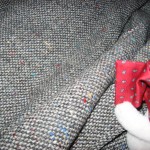 often called “barley-corn” tweed. These are usually marked by contrasted colors on the little bumps or barley-corns.
often called “barley-corn” tweed. These are usually marked by contrasted colors on the little bumps or barley-corns.
A Donegal tweed, from the northern counties of Ireland where Dr Bear’s people came from, is a little more regular than the more over-the-top barley-corn, in regular little patterns.
This can be small or big,
subtle or less so.
It can be gradations of the same color, sympathetic colors, or even contrasting colors.
If you want loud, wear Argyle or Tartan, not Tweed.
If you want ugly, wear Madras, and please stay far away.
Another design is Herring-bone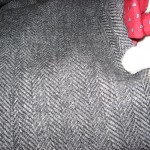
tweed, named because the alternating diagonal patterns
look like fish bones.
This is classic, and probably my favorite.
Another is hounds-tooth, 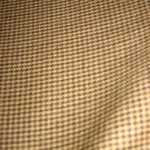 an irregular design vaguely resembling a dog’s tooth. (shudder.) This one on my left is a tan and brown summer weight, so it can be worn in warmer weather.
an irregular design vaguely resembling a dog’s tooth. (shudder.) This one on my left is a tan and brown summer weight, so it can be worn in warmer weather.

A well-known non-traditional variation on this is the iconic black & white hounds-tooth. Which is classy, but mostly for women’s wear.
It makes me think of Audrey Hepburn, which is always good. sigh.
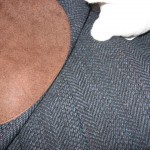 And, as I said, any design can come in different colors, like this blue herringbone tweed.
And, as I said, any design can come in different colors, like this blue herringbone tweed.
Unlike gray and brown, blue is not a conventional tweed color, but I suppose we would not expect conventional from Dr Bear.
Also, you can alternate patterns, 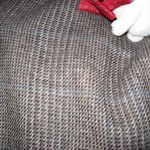 like check and hounds-tooth, to get new combinations.
like check and hounds-tooth, to get new combinations.
This one alternates a wider hounds-tooth with a smaller one (pups-tooth. Yes! Really! giggle.) and is woven with a light bluish over-check.
In the 19th century, many of the great country houses had their distinct house tweed, created by alternating patterns in a set way. This is called Estate Tweed.
Not at all the same as tartan.
Classy, but tied to hunting, so uncool.
Having the participants well-dressed certainly does not dress up a blood sport.
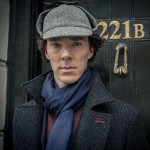
It is warm, and surprisingly water resistant, having many of the natural properties of sheep wool. It is classy, although not formal—never a business suit, or dinner-wear. It is the material of Sherlock’s Deer Stalker.
It also looks great with bow-ties.
Happy 450th, dear Bard.

I watched The Shakespeare Code (DWS03E02) last night, but tonight I am going to try for The Hollow Crown.
Goodnight.
Status
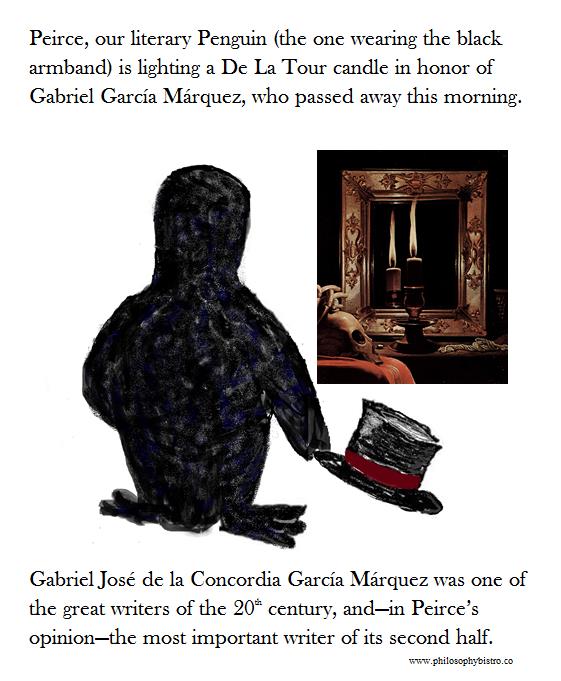
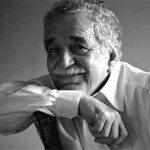 In honour of Gabriel García Márquez, who passed on this morning.
In honour of Gabriel García Márquez, who passed on this morning.
It amazes me how writing can be new, fresh, exotic and strange, and yet at the same time feel ancient and familiar.
The Once and Future Library
Do you remember the feeling of your first library?
To be surrounded by so many books was like suddenly  being allowed into Aladdin’s cave: so many treasures that they seemed limitless. Then as now, I always want to take more than I could possibly read in those two weeks. Then as now, I am drawn to them–even more than I am to bookstores; they are not home, but they are a haven. Although my parents had quite a good library, I was always reading, and always had a few books checked out, as well as a few on my list.
being allowed into Aladdin’s cave: so many treasures that they seemed limitless. Then as now, I always want to take more than I could possibly read in those two weeks. Then as now, I am drawn to them–even more than I am to bookstores; they are not home, but they are a haven. Although my parents had quite a good library, I was always reading, and always had a few books checked out, as well as a few on my list.
I remember taking my own daughter to libraries and us staying there for hours. There was a 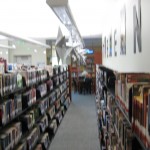 stillness and sunshine, but also amazing librarians–helpful, kind, and bookish. At first, Grace came for the excitement of the public story-time, but soon she came for the books. She would lose herself for hours on some beanbag or chair or table. We each felt a magic to walking down the stacks–those rows and rows of shelves, all housing dazzling wonders.
stillness and sunshine, but also amazing librarians–helpful, kind, and bookish. At first, Grace came for the excitement of the public story-time, but soon she came for the books. She would lose herself for hours on some beanbag or chair or table. We each felt a magic to walking down the stacks–those rows and rows of shelves, all housing dazzling wonders. In the book Inkheart, by Cornelia Funke, the bookbinder Mo has told his daughter: “Books have to be heavy because the whole world’s inside them.
In the book Inkheart, by Cornelia Funke, the bookbinder Mo has told his daughter: “Books have to be heavy because the whole world’s inside them.
My whole family has always felt the same way; to walk down those shelves is to travel across multiverses.
One of our great pleasures in Europe was to see that libraries  were still going strong there as well, as we could see when there was a half acre of bicycles parked by one in Munich.
were still going strong there as well, as we could see when there was a half acre of bicycles parked by one in Munich.
Since I have spent 13 years of my life working in bookstores and only a year or so in a library (I was a OCLC monographs cataloguer rather than a librarian who dealt with the public), I do think of myself as more of a bookseller–pirate to the librarians’ ninjas. However, I do adore them, my librarians, and am grateful to them.
Happy National Library Month, you wonderful, lovely, crazy bunch.
The book industry is going through a tremendous upheaval.
Books are certainly not dead, but they are changing, and their role in our lives is changing. Does this mean the end of libraries?
Don’t be silly.
People will always want books, in fact, people will always need books.
One of the great services libraries have provided is that they have brought books to huge numbers of people, many of whom might not 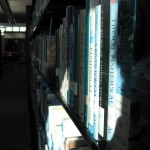 have had any chance of reading them otherwise. Three centuries ago, few houses had more than one or two books, and many had none. Two centuries ago, only the rich had more than a shelf-full. Even a century ago, books were expensive, and many could not afford them, escecially outside of the middle and upper classes. Libraries put books within the reach of almost everyone. Great fiction (or exciting but not so great fiction), could be in anyone’s hands, as could biographies and travelogues of faraway places, science and engineering books, huge dictionaries and medical encyclopedia, as well as things like atlases and maps. President Harry S Truman, who had to support his family and was unable to finish school, is said to have educated himself by reading most of the Hannibal, Missouri, Public Library. The steel
have had any chance of reading them otherwise. Three centuries ago, few houses had more than one or two books, and many had none. Two centuries ago, only the rich had more than a shelf-full. Even a century ago, books were expensive, and many could not afford them, escecially outside of the middle and upper classes. Libraries put books within the reach of almost everyone. Great fiction (or exciting but not so great fiction), could be in anyone’s hands, as could biographies and travelogues of faraway places, science and engineering books, huge dictionaries and medical encyclopedia, as well as things like atlases and maps. President Harry S Truman, who had to support his family and was unable to finish school, is said to have educated himself by reading most of the Hannibal, Missouri, Public Library. The steel 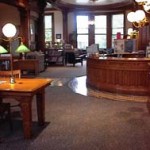 magnate Andrew Carnegie endowed 2,509 libraries–including another one of my libraries, the public Library in Lincoln, Illinois)–in part because he felt they provided an opportunity for the “working man” to better himself. For years, they were a place anybody could learn, as well as an important public space in most American communities.
magnate Andrew Carnegie endowed 2,509 libraries–including another one of my libraries, the public Library in Lincoln, Illinois)–in part because he felt they provided an opportunity for the “working man” to better himself. For years, they were a place anybody could learn, as well as an important public space in most American communities.
This continues.
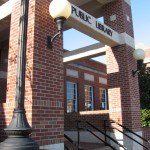 This continues in large part because of the way libraries and librarians have approached the problem. They are adapting–not always perfectly, not always smoothly, but they are adapting. The see what the new needs are, and work to meet them where they are. Precisely those things that are changing the world of books are making libraries more important.
This continues in large part because of the way libraries and librarians have approached the problem. They are adapting–not always perfectly, not always smoothly, but they are adapting. The see what the new needs are, and work to meet them where they are. Precisely those things that are changing the world of books are making libraries more important.
It makes me furious when I hear someone describe the internet and e-books as accessible or convenient or free.
They are not.
Neither are they democratic.
Nothing that requires a hundred dollar piece of equipment–and most nooks, kindles, smartphones, etc. are more than that, while genuine laptops and iPhones or iPads can be much, much more–is free. Nothing that requires a service contract to provide internet access, WiFi or data packages is free.
In addition to this, nothing that costs this much is convenient or accessible for citizens of modest means (“Oh honey, mine aren’t just modest; they’re downright meek–shy to the point of agoraphobic”). These folks, who are becoming more and more common in this “New Normal,” are still finding resources at their local public libraries (since students in higher education are also of timid means, these necessary resources continue to be offered to them–even fought for–by college and university libraries).
or accessible for citizens of modest means (“Oh honey, mine aren’t just modest; they’re downright meek–shy to the point of agoraphobic”). These folks, who are becoming more and more common in this “New Normal,” are still finding resources at their local public libraries (since students in higher education are also of timid means, these necessary resources continue to be offered to them–even fought for–by college and university libraries).
I am not talking about the homeless–although the book gods know how much they use the libraries–I am talking about hard-working people trying to carve out a decent life by holding down 2 or 3 part-time jobs.
In addition to still providing books, an amazing way that libraries have adapted is to provided computer and internet access,  as well as some printing. I chatted with one of my local librarians–4 blocks from the Bistro, and although they don’t keep records of use, their 30+ terminals are all in use several times each day, often with people waiting.
as well as some printing. I chatted with one of my local librarians–4 blocks from the Bistro, and although they don’t keep records of use, their 30+ terminals are all in use several times each day, often with people waiting.
This is important.
All those government websites that make information “more” available require internet access. Many of those applications for Medicare or Veterans’ benefits require internet access. Most job applications are now made “easier” by requiring internet access. In an age of “instant” communication, that communication is only accessible to those with internet access.
Public libraries provide that, not just to the margins of our society, but to its foundation, as well as to the foundation of our future.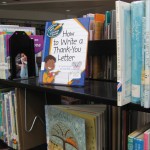
Libraries have also stepped into the electronic world by lending e-books and freegal, making those more accessible to folks with computers and e-readers, especially to those who cannot make the trip to the library–due to lack of mobility or of transportation.
Of course, all of us–those of modest means, those of the crunched middle means, and even those of comfortable means–can still take our children, our nieces and nephews, or grandchildren to wander down those magic aisles curiously–looking to be fed on words.
Celebrate National Library Month, and hug a librarian.
On second thought, they are book-people; thank them from a distance of at least 3 feet.
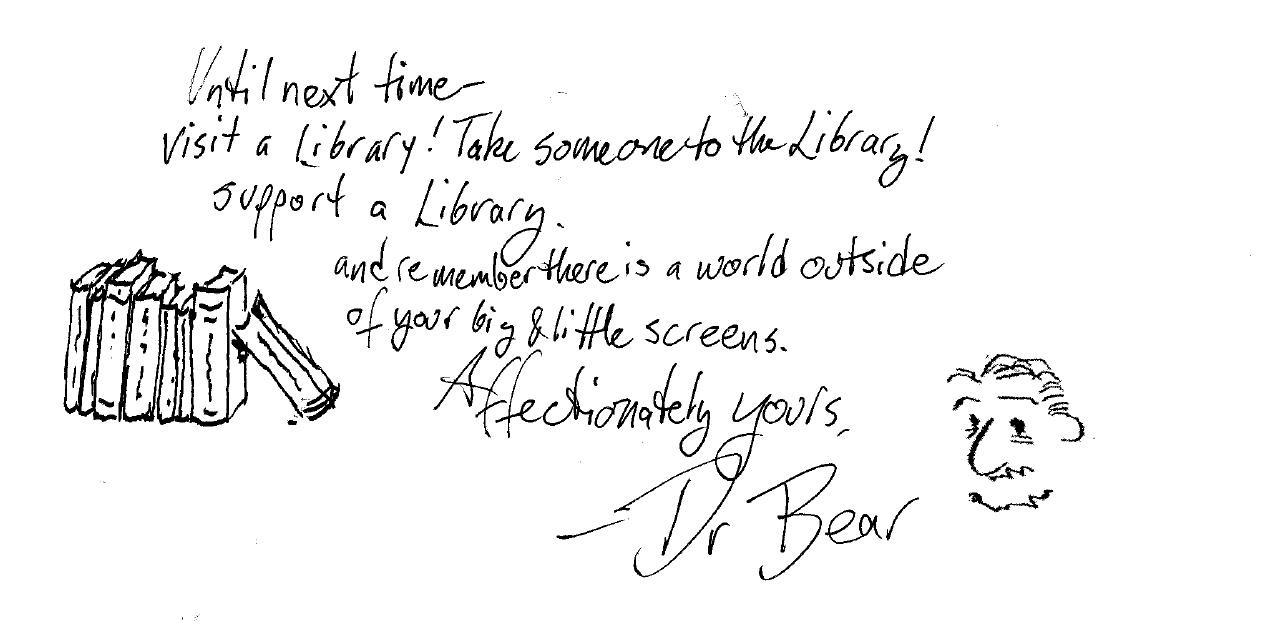
The boys.
Image
Jim is running the Boston Marathon
Also, a good friend and great person is running in the Boston Marathon next week.
Along with this, he has a FirstGiving page to raise money for research through the Huntington’s Disease Society of America (HDSA). Huntington’s is a terrifying disease that has touched Jim & his family deeply.
Please consider donating donate, and either way, root for Jim.
https://www.firstgiving.com/fundraiser/jim-dahlman/bostonmarathon
Also, if you are in town, Jim is speaking at Milligan College tonight at 7;00 on the Wilderness Trail, which he walked this summer, and is writing a book on.
Tuesday Night Question:
This Weekend
TWO NIGHTS ONLY:
MISTER PARADISE
a short one-act play by Tennessee Williams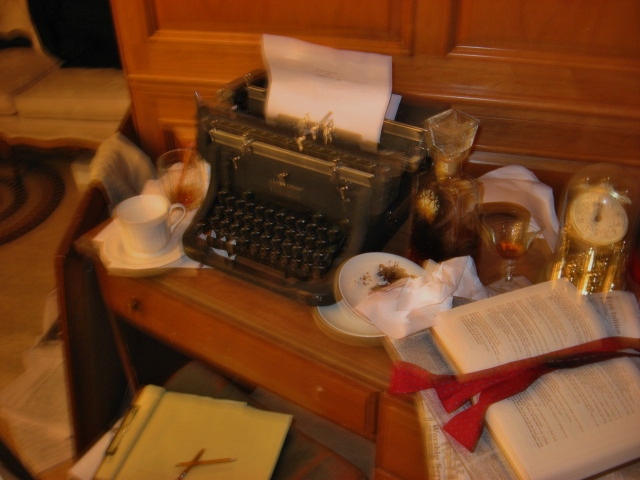
A young woman goes to a squalid apartment in the French Quarter to find her hero, the forgotten poet Anthony Paradise. The man she finds is less than she had hoped and expected, but also more.
Directed by Daniel Banks, and performed by Mandy Chambers as “The Girl” and Robert Shields as Mr. Anthony Paradise.

